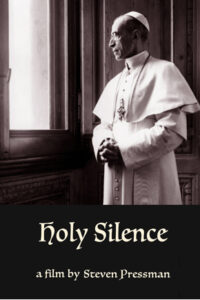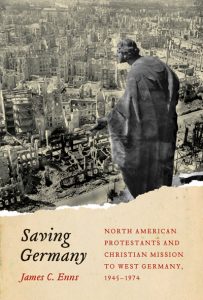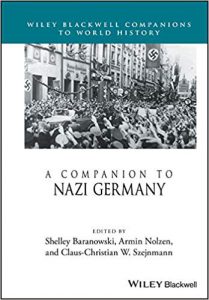Contemporary Church History Quarterly
Volume 30, Number 3 (Fall 2024)
Article Note: Bastiaan Bouwman, “Between Dialogue and Denunciation: The World Council of Churches, Religious Freedom, and Human Rights during the Cold War,” Contemporary European History 31 (2022): 15-30.
Rebecca Carter-Chand, USHMM*
* The views expressed are those of the author and do not represent those of the United States Holocaust Memorial Museum.
In this article, and the dissertation from which it emerged, Dutch historian Bastiaan Bouwman traces the evolution of the World Council of Churches (WCC) during the Cold War, in light of shifting concepts of religious freedom and human rights. Bouwman shows how the World Council of Churches’ early embrace of religious freedom, diplomacy, and dialogue increasingly became at odds with the organization’s reorientation to the Global South and the recasting of human rights as a language of public denunciation. At the center of this story is the WCC’s relationship with the Russian Orthodox Church, which was granted WCC membership in 1961. Aware of the Orthodox Church’s limitations and precarious position in a communist state, the WCC pursued a policy of ecumenical engagement with church leaders in a genuine attempt to help the Church sustain itself. Western representatives within the WCC were careful to avoid jeopardizing the Russian Orthodox Church’s position through overt criticism of the state.
Throughout the 1960s it became increasingly clear that this policy was out of step with the intensifying religious and political dissidence in the Soviet Union. After Aleksandr Solzhenitsyn sent a letter to the head of the Russian Orthodox Church in 1972, criticizing the Church hierarchy for submitting to the state, a debate emerged about how and to what extent the Church ought to push for religious freedom. The WCC largely sided with the Church hierarchy, which argued that the Church ought to accept its circumstances and work within the system. Bouwman contextualizes this debate within international politics in these same years, which embraced dissidents and placed them at the center of human rights language. Moreover, diverse religious voices began to engage the language of human rights to criticize religious repression in the Eastern Bloc, from American evangelicals to Pope John Paul II.
At the same time, the World Council of Churches itself was undergoing a major reorientation to the Global South, as decolonization, liberation theology, and social justice became important themes. In this context, the WCC’s policy toward the Soviet Union and the Russian Orthodox Church seemed incongruent with its willingness to speak out against human rights violations in other parts of the world. Bouwman concludes that the WCC’s decision not to support Soviet dissidents “damaged its credibility as a truly global voice for human rights.” (p.30) The organization also faced internal and external tensions related to decolonization and late-Cold War geopolitics. In this way, the trajectory of the WCC highlights broader tensions between anticommunism strands of human rights advocacy and the activism of postcolonialism and social justice in the last decades of the twentieth century.

 The main source material that Madigan draws upon comes from the pontificate of Pius XI (1922-1939), the records of which only became available in 2006. But the story begins in the Risorgimento in the mid-nineteenth century and the triumph of a new liberal order that brought religious tolerance in the form of openness to non-Catholic religious confessions. Into this environment emerged evangelical Protestant missionaries from England and America, many of whom were Italian immigrants who had converted to a form of Protestantism in their new country and later returned to Italy. Methodists, Baptists, Pentecostals, the Salvation Army, the YMCA, Jehovah’s Witnesses, and Adventists brought with them an evangelical style of preaching that emphasized conversion and an array of educational, medical, and social programs that benefited the Italian lower classes and peasantry. The fact that this Protestant missionary activity mapped onto a global trend of Protestant expansion in this period was all the more concerning for the Vatican, especially after World War I and the growth of Anglo-American power.
The main source material that Madigan draws upon comes from the pontificate of Pius XI (1922-1939), the records of which only became available in 2006. But the story begins in the Risorgimento in the mid-nineteenth century and the triumph of a new liberal order that brought religious tolerance in the form of openness to non-Catholic religious confessions. Into this environment emerged evangelical Protestant missionaries from England and America, many of whom were Italian immigrants who had converted to a form of Protestantism in their new country and later returned to Italy. Methodists, Baptists, Pentecostals, the Salvation Army, the YMCA, Jehovah’s Witnesses, and Adventists brought with them an evangelical style of preaching that emphasized conversion and an array of educational, medical, and social programs that benefited the Italian lower classes and peasantry. The fact that this Protestant missionary activity mapped onto a global trend of Protestant expansion in this period was all the more concerning for the Vatican, especially after World War I and the growth of Anglo-American power. The film features several academics familiar to CCHQ readers, including members of the editorial team Kevin Spicer and Suzanne Brown-Fleming. Interviews with Robert Ventresca, Susan Zuccotti, Michael Phayer, Maria Mazzenga, and many others are interspersed with historic footage, and occasional re-enactment to explore the actions of popes Pius XI and XII and some of the innerworkings of the Vatican. Pressman offers a range of voices, including a few outliers like Norbert Hofmann, Secretary of the Holy See’s Commission for Jewish Relations, who views Pius XII in a sympathetic light. We also hear contrasting viewpoints from Sister Maria Pascalizi of the Roman Convent of Santa Maria dei Sette Dolori and Micaela Pavoncello, a local Jew, about the Vatican’s role in sanctioning or encouraging the hiding of Jews in churches.
The film features several academics familiar to CCHQ readers, including members of the editorial team Kevin Spicer and Suzanne Brown-Fleming. Interviews with Robert Ventresca, Susan Zuccotti, Michael Phayer, Maria Mazzenga, and many others are interspersed with historic footage, and occasional re-enactment to explore the actions of popes Pius XI and XII and some of the innerworkings of the Vatican. Pressman offers a range of voices, including a few outliers like Norbert Hofmann, Secretary of the Holy See’s Commission for Jewish Relations, who views Pius XII in a sympathetic light. We also hear contrasting viewpoints from Sister Maria Pascalizi of the Roman Convent of Santa Maria dei Sette Dolori and Micaela Pavoncello, a local Jew, about the Vatican’s role in sanctioning or encouraging the hiding of Jews in churches. Because this is a work of social science, it employs a methodology very different from how historians approach research and thus warrants some explanation. Braun begins with a hypothesis that religious minorities are more likely to assist or rescue persecuted groups from mass violence or genocide. In this framing, religious minorities could hold minority status on a national level because of their small size (e.g., Quakers) or they could be a minority in a given region—Catholics in a majority Protestant region and vice versa. This minority theory is based on the idea that religious minorities recognize a shared vulnerability with other minorities, which triggers empathy. Braun posits that all religious communities seek security and self-preservation. When they cannot achieve this through religious dominance, then pluralism is the next safest option to ensure survival. So, a commitment to pluralism accounts for the willingness factor but minority status also enables capacity. Minority communities are able to engage in clandestine collective action while reducing exposure because of their members’ commitment and their relative isolation (more on isolation below). (40)
Because this is a work of social science, it employs a methodology very different from how historians approach research and thus warrants some explanation. Braun begins with a hypothesis that religious minorities are more likely to assist or rescue persecuted groups from mass violence or genocide. In this framing, religious minorities could hold minority status on a national level because of their small size (e.g., Quakers) or they could be a minority in a given region—Catholics in a majority Protestant region and vice versa. This minority theory is based on the idea that religious minorities recognize a shared vulnerability with other minorities, which triggers empathy. Braun posits that all religious communities seek security and self-preservation. When they cannot achieve this through religious dominance, then pluralism is the next safest option to ensure survival. So, a commitment to pluralism accounts for the willingness factor but minority status also enables capacity. Minority communities are able to engage in clandestine collective action while reducing exposure because of their members’ commitment and their relative isolation (more on isolation below). (40) Enns examines a range of Protestant missionary responses to postwar Germany and divides his subjects into three broad categories. Ecumenical missionaries were mainline Protestants who worked primarily through the Religious Affairs Section of the American Military Government in Germany, the World Council of Churches (WCC), and the Church World Service. They were invested primarily in relief and reconstruction, particularly helping to rebuild the Evangelische Kirche Deutschland (the main Protestant church) as a pillar of German society. Denominational missionaries represent the second approach, and here Enns focuses on the Baptists and Mennonites. These denominations used pre-existing ties to their German counterparts and sought to build up these communities and their standing in German society. The third category is conservative evangelical missionaries who worked through independent mission organizations of a mid-century fundamentalist bent. The impact of organizations like Youth for Christ and Janz Team Ministries is not well known and the author does a good job integrating these organizations in the larger narrative.
Enns examines a range of Protestant missionary responses to postwar Germany and divides his subjects into three broad categories. Ecumenical missionaries were mainline Protestants who worked primarily through the Religious Affairs Section of the American Military Government in Germany, the World Council of Churches (WCC), and the Church World Service. They were invested primarily in relief and reconstruction, particularly helping to rebuild the Evangelische Kirche Deutschland (the main Protestant church) as a pillar of German society. Denominational missionaries represent the second approach, and here Enns focuses on the Baptists and Mennonites. These denominations used pre-existing ties to their German counterparts and sought to build up these communities and their standing in German society. The third category is conservative evangelical missionaries who worked through independent mission organizations of a mid-century fundamentalist bent. The impact of organizations like Youth for Christ and Janz Team Ministries is not well known and the author does a good job integrating these organizations in the larger narrative. In just 13 pages Manfred Gailus gives an overview of the Christian churches and religious identity and practice in Germany during the 12 years of Nazi rule. Rather than placing the Kirchenkampf and an assessment of the Catholic hierarchy at the centre of this narrative, Gailus paints a picture in which several diverse religious groups quarreled and competed with each and with the state. In addition to the Deutsche Christen, the Confessing Church, and the Catholic Church, he discusses the Free Churches, other small independent religious communities (Adventists, Quakers, Jehovah’s Witnesses, etc.), and völkisch ‘new pagan’ groups (including the German Faith Movement and the Ludendorff movement). These völkisch-religious groups, whose proponents were called “German Believers,” need to be differentiated from the similarly-named “Believers in God” (a new label for those ardent Nazis who had left the church).
In just 13 pages Manfred Gailus gives an overview of the Christian churches and religious identity and practice in Germany during the 12 years of Nazi rule. Rather than placing the Kirchenkampf and an assessment of the Catholic hierarchy at the centre of this narrative, Gailus paints a picture in which several diverse religious groups quarreled and competed with each and with the state. In addition to the Deutsche Christen, the Confessing Church, and the Catholic Church, he discusses the Free Churches, other small independent religious communities (Adventists, Quakers, Jehovah’s Witnesses, etc.), and völkisch ‘new pagan’ groups (including the German Faith Movement and the Ludendorff movement). These völkisch-religious groups, whose proponents were called “German Believers,” need to be differentiated from the similarly-named “Believers in God” (a new label for those ardent Nazis who had left the church).